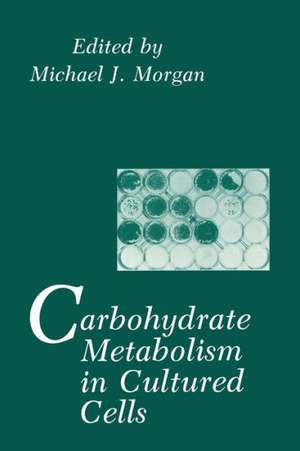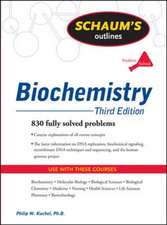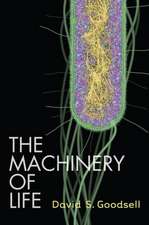Carbohydrate Metabolism in Cultured Cells
Editat de M.J. Morganen Limba Engleză Paperback – 26 noi 2012
Preț: 400.65 lei
Nou
Puncte Express: 601
Preț estimativ în valută:
76.67€ • 79.75$ • 63.30£
76.67€ • 79.75$ • 63.30£
Carte tipărită la comandă
Livrare economică 14-28 aprilie
Preluare comenzi: 021 569.72.76
Specificații
ISBN-13: 9781468476811
ISBN-10: 1468476815
Pagini: 540
Ilustrații: 536 p. 18 illus.
Dimensiuni: 152 x 229 x 28 mm
Greutate: 0.71 kg
Ediția:Softcover reprint of the original 1st ed. 1986
Editura: Springer Us
Colecția Springer
Locul publicării:New York, NY, United States
ISBN-10: 1468476815
Pagini: 540
Ilustrații: 536 p. 18 illus.
Dimensiuni: 152 x 229 x 28 mm
Greutate: 0.71 kg
Ediția:Softcover reprint of the original 1st ed. 1986
Editura: Springer Us
Colecția Springer
Locul publicării:New York, NY, United States
Public țintă
ResearchCuprins
1 Studies of Regulation of Hexose Transport into Cultured Fibroblasts.- 1. Introduction.- 2. Hexose Uptake or Transport Tests.- 3. Metabolic Pathways.- 4. Characterization of Certain Cellular Macromolecules and Structures.- 5. Effects of Glucose Starvation on a Variety of Plasma Membrane Proteins.- 6. The Glucose-Mediated Curb of Hexose Transport Requires Oxidative Energy.- 7. Nucleoside Triphosphate Levels in Cultured Fibroblasts as a Function of General Metabolism and Nutrition.- 8. Hexose Transport Regulation and Oncogenic Transformation of Cultured Fibroblasts.- 9. Evolutionary Aspects.- References.- 2 The Utilization of Carbohydrates by Animal Cells: An Approach to Their Biochemical Genetics.- 1. The Utilization of Carbohydrates.- 2. Glycolysis.- 3. The Provision of Energy.- 4. Pentose Phosphate Pathway.- 5. Differentiation.- 6. Other Effects of Carbohydrates.- 7. Concluding Remarks.- References.- 3 Biochemical Genetics of Respiration-Deficient Mutants of Animal Cells.- 1. Introduction.- 2. The Selection of Respiration-Deficient Mammalian Cell Mutants.- 3. Glycolysis and Respiration in Wild-Type Parents and res— Mutants.- 4. Biochemical Characterization of Mutants.- 5. Genetic Characterization of Mutants.- 6. Work in Progress and Future Prospects.- 7. Summary.- References.- 4 Glutaminolysis in Animal Cells.- 1. Glutamine Metabolism in Mammals.- 2. Glutaminolysis in Tissues.- 3. Glutaminolysis in Isolated Tissues and Primary Cell Suspensions.- 4. Glutaminolysis in Normal and Tumor Cells in Culture.- 5. Glutaminolysis-The Pathway of Glutamine Oxidation.- 6. Glutaminolysis and Glycolysis in Cell Growth and Function.- 7. Conclusions.- 8. Addendum.- References.- 5 The Metabolism and Utilization of Carbohydrates by Suspension Cultures of Plant Cells.- 1. Introduction.-2. Carbon Sources for Culture Growth.- 3. Uptake Mechanisms for Carbon Sources.- 4. Intracellular Fate of Carbon Source-Biochemistry: Oxidation, Biosynthesis, Storage.- 5. Summary Comments.- References.- 6 Carbohydrate Metabolism in African Trypanosomes, with Special Reference to the Glycosome.- 1. Introduction.- 2. Life Cycle.- 3. Methods for Cultivation.- 4. Substrates and End Products of Metabolism.- 5. Terminal Respiratory Systems.- 6. The Glycosome.- 7. Pathways of Glucose Metabolism.- 8. Glycolysis as a Target for Chemotherapy.- 9. Summary and Outlook.- References.- 7 Sugar Transport Systems of Baker’s Yeast and Filamentous Fungi.- 1. Yeast.- 2. Filamentous Fungi.- References.- 8 Carbohydrate Metabolism in Yeast.- 1. Introduction.- 2. Methodological Approaches.- 3. Overview of the Pathways of Carbohydrate Metabolism.- 4. Regulatory Mechanisms.- 5. Conclusions.- References.- 9 Regulation of Carbon Metabolism in Filamentous Fungi.- 1. Introduction.- 2. Extracellular Formation of Hexoses from Polysaccharides.- 3. Growth on Glucose and Related Carbon Sources.- 4. Growth on Three-Carbon Substrates.- 5. Growth on Acetate or Ethanol.- 6. Growth on Substrates Utilized via the Tricarboxylic Acid Cycle.- 7. Conclusions.- References.- 10 The Bacterial Phosphoenolpyruvate: Sugar Phosphotransferase System of Escherichia coli and Salmonella typhimurium.- 1. Introduction.- 2. The PEP:Sugar PTS: An Overview.- 3. Components of the PTS.- 4. In Vitro Phosphorylation of Sugars by the PTS.- 5. Transport via the PTS.- 6. Role of the PTS in Chemotaxis.- 7. Genetics of the PTS.- 8. Phenotype of PTS Mutants.- 9. Regulation by the PTS.- 10. Comparison with Other Regulatory Mechanisms.- References.- 11 Active Transport of Sugars into Escherichia coli.- 1. Introduction.- 2. ExperimentalSystems for Measuring Transport.- 3. Proton-Linked Sugar Transport Systems.- 4. Cation-Linked Melibiose Transport.- 5. Binding Protein Sugar Transport Systems.- 6. New Developments.- References.- 12 Convergent Pathways of Sugar Catabolism in Bacteria.- 1. Introduction.- 2. Pathways for the Degradation of Glucose.- 3. Individual Catabolic Pathways Leading to Central Intermediates.- 4. Epilogue.- References.











